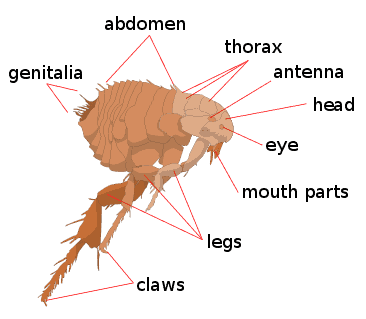Fleas are insects that form the order Siphonaptera. They are wingless, with mouthparts adapted for piercing skin and sucking blood. Fleas are external parasites, living by hematophagy, off the blood of mammals and birds.
Flea species include:
- Cat flea (Ctenocephalides felis)
- Dog flea (Ctenocephalides canis)
- Human flea (Pulex irritans)
Morphology and behaviour
Fleas are wingless insects, 1/16 to 1/8-inch (1.5 to 3.3 mm) long, that are agile, usually dark coloured (for example, the reddish-brown of the cat flea), with tube-like mouth parts adapted to feeding on the blood of their hosts. They interestingly do not possess a mandible. Their legs are long, the hind pair well adapted for jumping; a flea can jump vertically up to 7 in (18 cm) and horizontally up to 13 in (33 cm), making the flea one of the best jumpers of all known animals (relative to body size). If humans had the jumping power of a flea, a 1.8-m (6-ft) person could make a jump 90 m (295 ft) long and 49 m (160 ft) high. Their legs end in strong claws that are designed to grasp a host. Fleas take off from their tibiae and tarsi (the insect equivalent of feet) and not their trochantera, or knees. It has been known that fleas do not use direct muscle power, but instead use the muscle to store energy in a protein named resilin before releasing it rapidly (like a human using a bow and arrow), with researchers using high-speed video technology and mathematical models to discover where the spring action actually happens.
Atypical of other insects, fleas do not possess compound eyes but instead have simple eyes with a single biconvex lens. Their eyes are known as “eyespots”. In some cases, there is no eyespot at all. Their bodies are laterally compressed, permitting easy movement through the hairs or feathers on the host’s body (or in the case of humans, under clothing). The flea body is covered with hard plates called sclerites. These sclerites are covered with many hairs and short spines directed backward, which also assist its movements on the host.
Fleas lay tiny, white, oval-shaped eggs better viewed through a magnifying glass. The larva is small and pale, has bristles covering its worm-like body, lacks eyes, and has mouth parts adapted to chewing. The larvae feed on various organic matter, especially the faeces of mature fleas. The adult flea’s diet consists solely of fresh blood. In the pupal phase, the insect is enclosed in a silken, debris-covered cocoon.
Life cycle and habitat
Fleas are holometabolous insects, going through the four lifecycle stages of egg, larva, pupa, and imago (adult). Adult fleas must feed on blood before they can become capable of reproduction.
Eggs
The flea life cycle begins when the female lays after feeding. Eggs are laid in batches of up to 20 or so, usually on the host itself, which means that the eggs can easily roll onto the ground. Because of this, areas where the host rests and sleeps become one of the primary habitats of eggs and developing fleas. The eggs take around two days to two weeks to hatch.
Larvae
Flea larvae emerge from the eggs to feed on any available organic material such as dead insects, faeces, conspecific eggs, and vegetable matter. In laboratory studies, some dietary diversity seems necessary for proper larval development. Blood-only diets allow only 12% of larvae to mature, whereas blood and yeast or dog chow diets allow almost all larvae to mature. Another study also showed that 90% of larvae matured into adults when the diet included nonviable eggs. They are blind and avoid sunlight, keeping to dark places such as sand, cracks and crevices, and bedding.
Pupae
Given an adequate supply of food, larvae pupate and weave silken cocoons within 1–2 weeks after three larval stages. After another week or two, the adult fleas are fully developed and ready to emerge. They may remain resting during this period until they receive a signal that a host is near – vibrations (including sound), heat, and carbon dioxide are all stimuli indicating the probable presence of a host. Fleas are known to overwinter in the larval or pupal stages.
Adult flea
Once the flea reaches adulthood, its primary goal is to find blood and then to reproduce. Its total life span can be as long as one and one-half years in ideal conditions. Female fleas can lay 5000 or more eggs over their life, allowing for phenomenal growth rates. Average 30–90 days.
A flea might live a year and a half under ideal conditions. These include the right temperature, food supply, and humidity. Generally speaking, an adult flea only lives for 2 or 3 months. Without a host for food a flea’s life might be as short as a few days. With ample food supply, the adult flea will often live up to 100 days.








